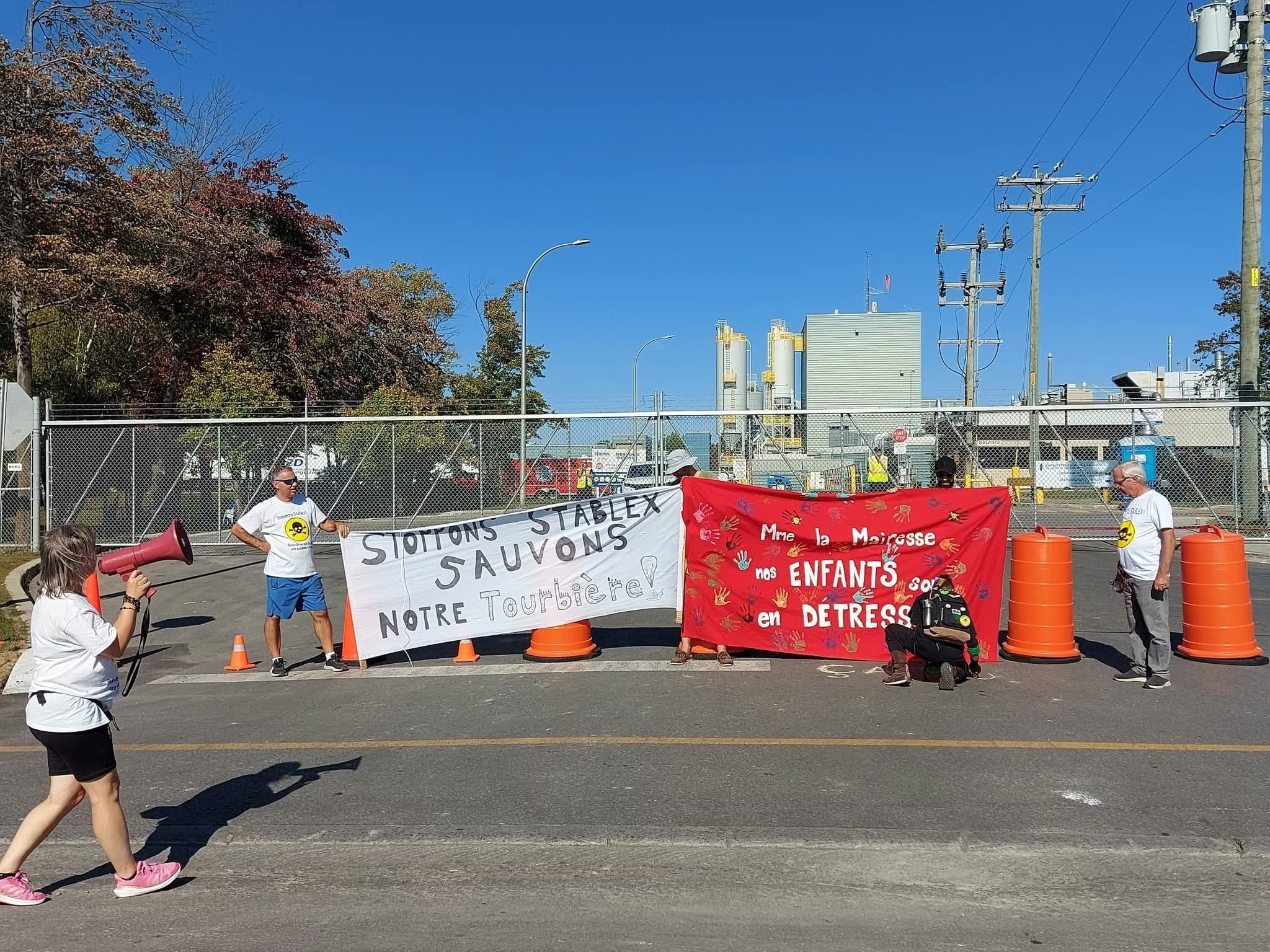Forced expropriation by the CAQ, hazardous waste imported from the United States, and growing public concern: it didn’t take much more for a movement of citizens, unions, and activists to form earlier this year in Blainville. Their initiatives, research, and a damning public environmental report have now shed light on the serious health risks still posed, forty years later, by the Stablex waste disposal site.
What does Stablex do, and why is it in the news now?
Since the 1980s, the American hazardous waste landfill company Stablex has been importing substances such as arsenic, lead, cadmium, cyanide, and chromium to treat and bury them near a residential neighborhood in Blainville. Around 70% of this waste comes from south of the border.
Stablex is owned by the largest waste management company in the United States, Republic Services. Republic Services is 35% owned by Bill Gates’ investment firm, Cascade Investments. The remaining shareholders are trillion-dollar investment giants like Vanguard, BlackRock, and State Street Corporation (Union Bank).
In 1981, the Quebec government authorized Stablex to build a sixth landfill cell, increasing its total capacity to nine million cubic meters by 2040. But forty years ago, Blainville was not yet a city surrounded by residential neighborhoods.
That’s why, toward the end of the last decade, the company proposed relocating slightly farther from the residential area, in exchange for an extension of its operations until 2065.
A new, more remote plot of land owned by the City of Blainville was sold to Stablex for $14 million, on the condition that the company obtain the required authorizations to begin the project.
In 2023, after the Quebec public hearings office on the environment (BAPE) released its public inquiry, Blainville’s city council unanimously voted to cancel the agreement with the American company. Stablex responded that the resolution had no legal value, claiming it did not comply with the terms of the contract.
In March 2025, Premier François Legault’s government came to Stablex’s rescue, allowing the company to begin “urgent” construction work to avoid a “service disruption.” The CAQ used an exceptional legislative procedure to bypass normal processes and expropriate the Blainville site without any democratic debate.
It’s worth noting that Stablex itself admits that without cell #6, it won’t reach maximum capacity before 2027. According to the BAPE report, the company actually has enough space until 2030.

A technology that’s neither effective nor safe
Stablex’s waste treatment relies on a British process from 1973 called “Sealosafe,” which mixes toxic waste with concrete before burying it in pits lined with clay that is supposed to prevent leaks.
Deemed obsolete for more than 35 years in the UK, this method is even less effective in Quebec’s climate. According to biologist Daniel Green, rain and freezing temperatures prevent the concrete from fully hardening, allowing contaminants to seep into the soil and groundwater. A report from Quebec’s environmental police as early as 1990 confirmed that the process was not “inert.”
Stablex claims its waste is not only inert but permanently so. Yet, a statement from Solomax, the company that supplies Stablex’s geomembrane liner, says it is guaranteed for only five years.
Moreover, according to the BAPE, Stablex has never tested soil or water quality around its site in over forty years, relying solely on laboratory simulations to assess its process. The report recommends that the Environment Ministry require direct analyses of the landfill cells and concludes that the expansion project should not be approved due to the lack of guarantees about its impact on public health and the environment.
And this time, the new cell #6 won’t be buried underground like the others: it will be a mountain of exposed waste. A mountain eight storeys tall, or 22 meters high, made of hazardous materials right next to a mostly residential city of just under 60,000 people.

So what is the environmental situation in Blainville?
Since neither the company nor the Environment Ministry had ever tested the quality of the soil or water near the Stablex site until very recently, about 30 citizens decided to do it themselves last spring, with the help of biologist Daniel Green to ensure the accuracy of the results.
The results only deepened residents’ concern. Now organized as the Blainville Citizens’ Coalition Against Stablex Cell #6, they found alarming concentrations of toxic metals: up to 320 times the safe limit for cadmium in water near the plant, 57 times in nearby soil, and unsafe levels of arsenic, copper, chromium, and nickel—particularly in the Lockhead Creek area, close to residential neighborhoods.
The Environment Ministry recently admitted it had already conducted sampling of soil and water near Stablex in 2024, but said results would only be made public “later this fall.” Contradicting the citizens’ findings, the government stated that according to its inspection report, Stablex “complies with current environmental standards.”
The ministry also published a report on air quality around the facility, saying: “There are currently no concerns regarding air quality.” Yet no study to date has demonstrated that the company’s new open-air waste storage method will not affect long-term air quality.

Be part of the conversation!
Only subscribers can comment. Subscribe to The North Star to join the conversation under our articles with our journalists and fellow community members. If you’re already subscribed, log in.